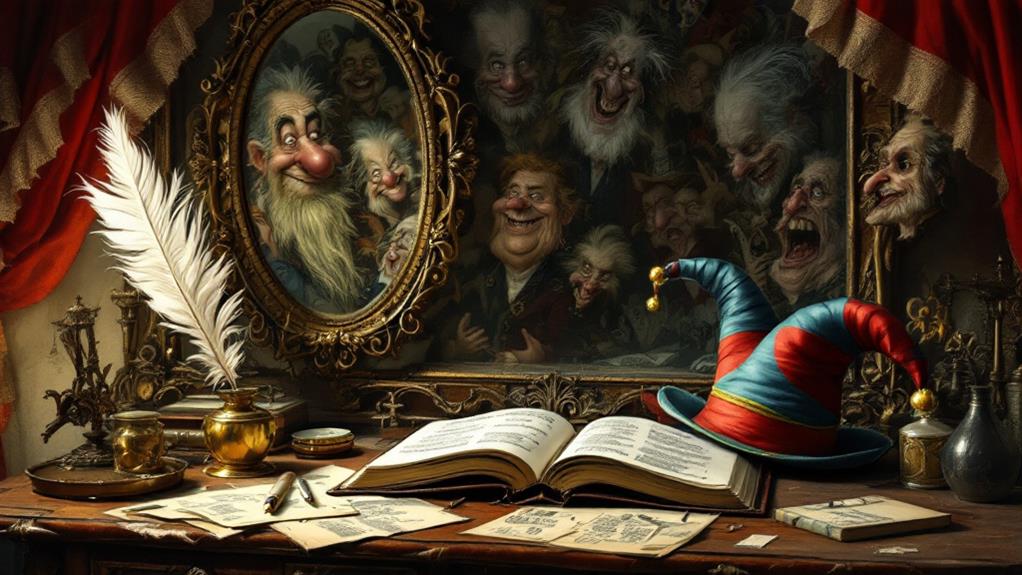What Are the Two Faces of Comedy?
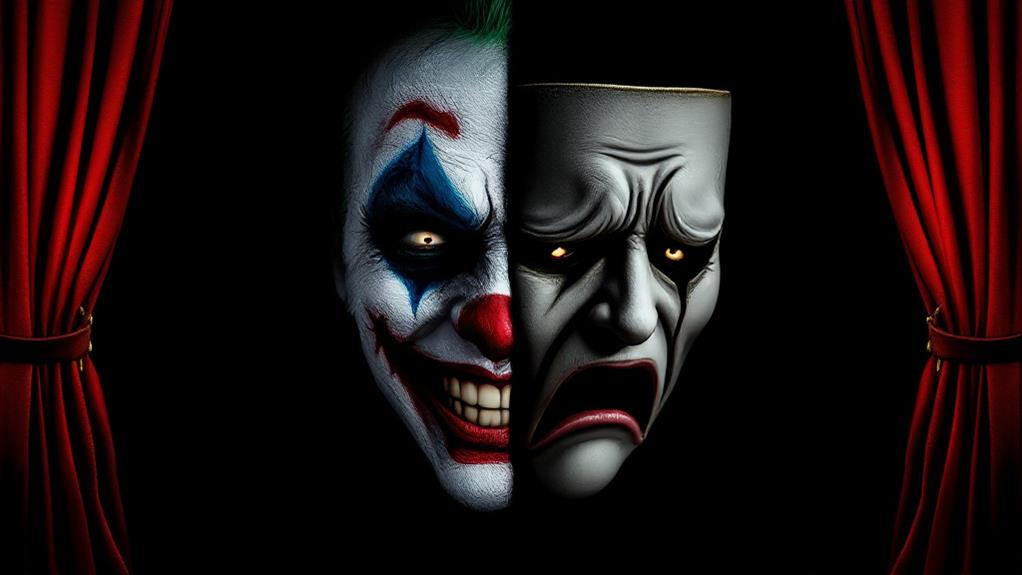
The two faces of comedy are represented by the iconic comedy and tragedy masks from ancient Greek theater. These masks symbolize Thalia, the Muse of Comedy, and Melpomene, the Muse of Tragedy. They embody the duality of human experience, with comedy reflecting joy and laughter, while tragedy depicts sorrow and suffering. Over time, these masks have evolved to become universal symbols of the performing arts. You'll find their influence in various artistic expressions, from theater logos to street art. They've shaped dramatic genres and continue to inspire creative works that investigate the intricacies of human emotions. There's much more to uncover about these enduring symbols.
Origin of Comedy Masks
Where did the iconic comedy mask we associate with theater originate? The roots of this familiar symbol can be traced back to ancient Greek theater, where masks played an essential role in dramatic performances. The comedy mask, in particular, has a fascinating history tied to Greek mythology.
In ancient Greek tradition, the comedy mask represented Thalia, the Muse of Comedy. Thalia was portrayed as a cheerful young woman, often adorned with an ivy crown, symbolizing the lighter and more joyful aspects of human experience. This mask, along with its tragic counterpart, became an enduring symbol of theater and the rich dramatic tradition of ancient Greece.
The comedy mask was designed with exaggerated and stylized features, allowing audience members to easily identify characters from a distance. One distinctive feature of the comedy mask was its thin-soled shoe, contrasting with the thick platform shoes worn by actors in tragic roles. This visual distinction helped spectators quickly differentiate between comedic and tragic characters on stage. Today, the comedy mask continues to be a recognizable emblem of theatrical arts, reminding us of its ancient Greek origins and the enduring legacy of Thalia's influence on comedy.
Thalia: Muse of Laughter
The cheerful face of comedy owes much to Thalia, the Greek Muse of laughter and merriment. As one of the nine Muses in Greek mythology, Thalia inspired playwrights and actors to create works that would entertain and uplift audiences. Her name, derived from the Greek word "thallein," meaning to flourish or bloom, reflects her association with joy and laughter.
You'll often find Thalia represented wearing a crown of ivy and holding a comic mask, symbolizing the lighter aspects of human experience. This mask, along with its tragic counterpart, has become an enduring symbol of the dramatic arts. When you see these paired masks, you're witnessing Thalia's lasting influence on theater and comedy.
As the Muse of Comedy, Thalia's domain extended beyond just humor. She was also associated with satire and idyllic poetry, encompassing a wide range of lighter literary forms. Her presence in Greek culture emphasized the importance of laughter and joy, providing a necessary counterbalance to the weight of tragedy in both art and life.
Melpomene: Tragic Counterpart
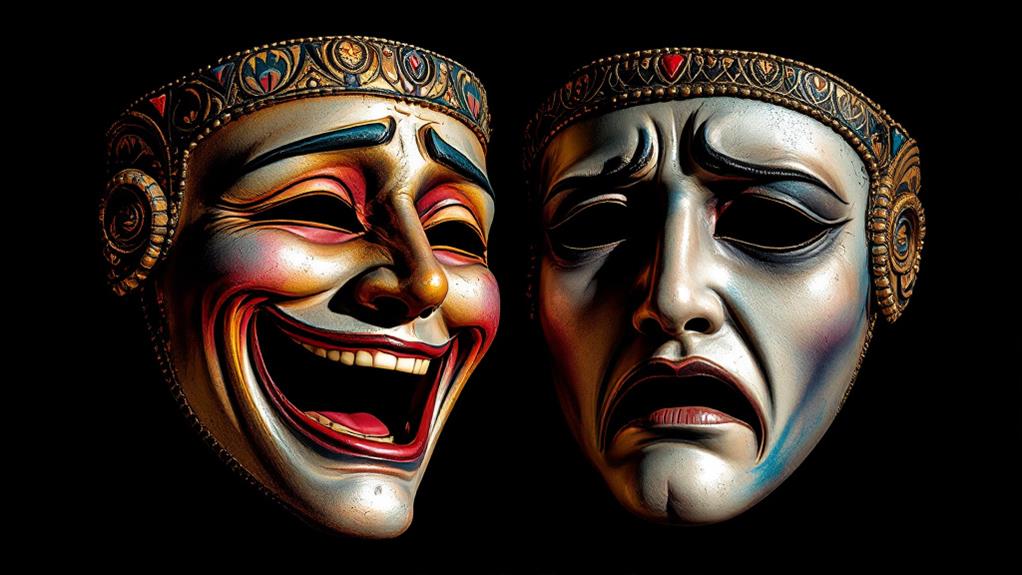
Comedy's darker sister, Melpomene, stands as the tragic counterpart to Thalia in Greek mythology. As the muse of tragedy, she represents the somber aspects of human existence, embodying the profound emotions that Greek theatre sought to evoke in its audience.
You'll often find Melpomene portrayed holding a tragic mask, a symbol of her domain in ancient Greek drama. She's also known for wearing cothurni, thick-soled platform shoes that elevated tragic actors on stage, literally and figuratively setting them apart from comedic performers.
In Greek theatre, Melpomene's influence was paramount. She inspired playwrights to craft stories that explored the depths of human suffering and moral dilemmas. Her name, derived from "melpomai," meaning to celebrate with song and dance, highlights the emotional power of tragic performances.
Melpomene's enduring legacy is evident in her continued use as a symbol for the melancholic side of the human condition. When you encounter her anguished expression in art or literature, you're witnessing the personification of tragedy itself, a reminder of the complex emotions that comedy often seeks to balance or alleviate.
Symbolism in Greek Theatre
Symbolism played a significant role in ancient Greek theatre, extending far beyond the tragic and comic masks associated with Melpomene and Thalia. The comedy and tragedy masks represented the extremes of human emotion, challenging actors to convey complex feelings through voice and movement alone. As you watch a Greek play, you'd notice how these exaggerated masks allowed the audience to identify characters from afar, enhancing the theatrical experience.
Thalia, the Muse of comedy, wore an ivy crown and a joyful expression, embodying the lighthearted aspects of life. In contrast, Melpomene, the Muse of tragedy, carried a knife or club and donned platform shoes, symbolizing the weight of human suffering. Tragic actors relied on these powerful symbols to convey deep emotions without facial expressions.
The interplay between comedy and tragedy in Greek theatre wasn't limited to masks. Dance and song also played essential roles in expressing the human condition. Today, these two masks have become universal symbols of theatre, inspiring contemporary artists and reminding us of the rich dramatic tradition that began in ancient Greece.
Evolution of Theatrical Masks
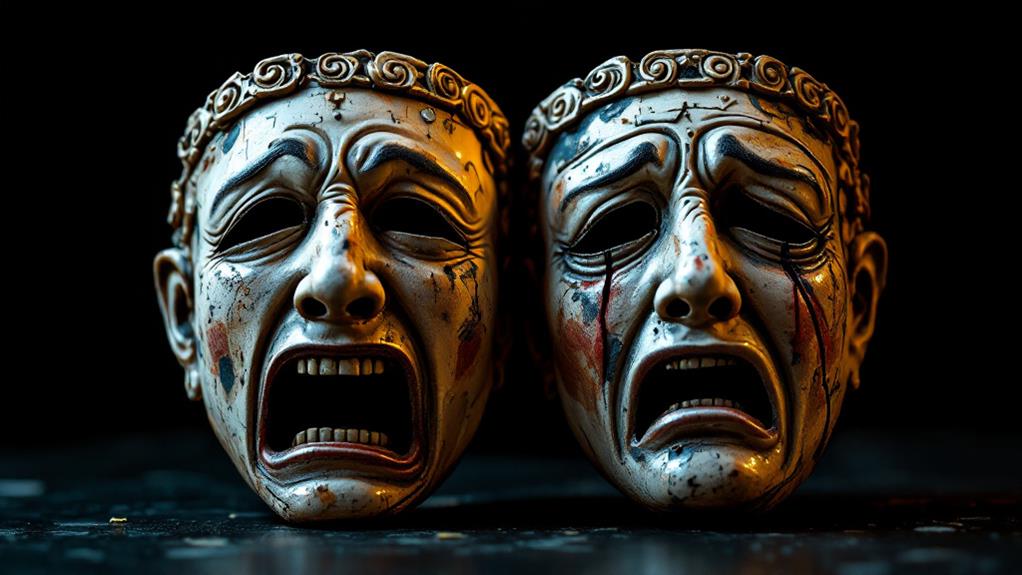
From ancient Greek theatre to modern stage productions, theatrical masks have undergone a fascinating evolution. In ancient times, you'd see performers wearing large, exaggerated masks to convey emotions and character traits to distant audiences. These masks were often associated with Dionysus, the Greek god of wine and theatre.
As theatre evolved, you'd notice the emergence of the iconic comedy and tragedy masks. These two masks, often represented side by side, symbolize the duality of human emotions: one happy and one sad. They've become synonymous with theatre itself.
During the Renaissance, you'd find masks playing a pivotal role in commedia dell'arte, with specific character types having their own distinct masks. In more recent times, you'll see masks used in experimental theatre, physical comedy, and even in some Broadway productions.
Today, while traditional mask use has declined, you'll still encounter them in various forms. From elaborate costume pieces to minimalist designs, masks continue to fascinate audiences and serve as powerful tools for storytelling and character transformation on stage.
Cultural Significance Through Time
How have the comedy and tragedy masks endured as powerful symbols throughout history? These iconic faces have outlived their origins in ancient Greek theatre to become universally recognized emblems of the performing arts. Originally associated with the god Dionysus and the two-faced god Janus, the masks also represent the muses Melpomene and Thalia, personifying tragedy and comedy respectively.
You'll find these masks adorning everything from Community Theatre posters to prestigious award statuettes, serving as a visual shorthand for the entire range of dramatic performance. Their enduring appeal lies in their ability to encapsulate the duality of human emotions – joy and sorrow – in a single, striking image.
As the masks evolved from physical costume pieces to symbolic representations, they've retained their power to evoke the emotional impact of live performance. Today, you'll recognize them instantly as emblems of creativity and artistic expression. Their lasting cultural significance stems from their capacity to represent the core of human experience as showcased through the performing arts, resonating with audiences across generations and cultures.
Representation in Modern Arts
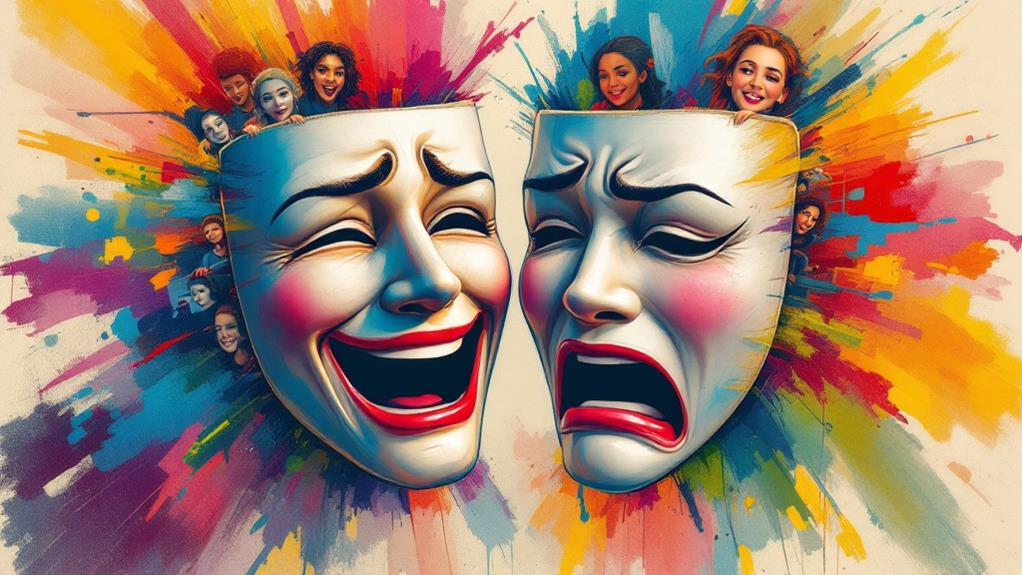
You'll find the comedy and tragedy masks everywhere in modern arts and culture. These iconic symbols have transcended their ancient origins to become ubiquitous representations of the performing arts. In contemporary design, artists and marketers continue to reimagine these classic images, infusing them with fresh interpretations that resonate with modern audiences.
The comedy mask and tragedy mask serve as powerful visual shorthand in branding for theaters, films, and creative industries. They evoke the full spectrum of human emotions explored through the arts. You'll encounter these symbols in:
- Sleek, minimalist logos for prestigious theater companies
- Bold, colorful street art murals depicting larger-than-life masks
- Stylized digital graphics for social media promotions of performances
- Abstract sculptures blending traditional mask shapes with novel materials
The enduring appeal of these masks lies in their ability to capture the essence of the human experience. As universal symbols, they bridge cultural divides and speak to the core of what makes us human. In the visual arts, you'll see artists pushing boundaries by incorporating these timeless icons into innovative digital art, immersive installations, and mixed-media works.
Duality of Human Experience
The comedy and tragedy masks embody more than just artistic symbols; they represent the fundamental duality of the human experience. These iconic faces, often seen in theater and arts, capture the essence of our emotional spectrum. You'll find that Melpomene and Thalia, the Muses of tragedy and comedy respectively, personify the contrasting aspects of human emotion.
This pairing comes from the Greek understanding of life's inherent contradictions. You're constantly exploring between joy and sorrow, laughter and tears. The smiling mask of Thalia reflects your moments of happiness and mirth, while Melpomene's frowning visage mirrors your darker, more sorrowful experiences.
As an audience member, you're drawn into this duality, experiencing a range of emotions through performances. The masks remind you that life isn't one-dimensional; it's a complex interplay of highs and lows. People often relate to both faces, recognizing their own experiences in each. This enduring symbol continues to echo, highlighting the diversity and complexity of human existence. It's a powerful reminder that your life, like art, encompasses the full spectrum of emotions.
Influence on Dramatic Genres
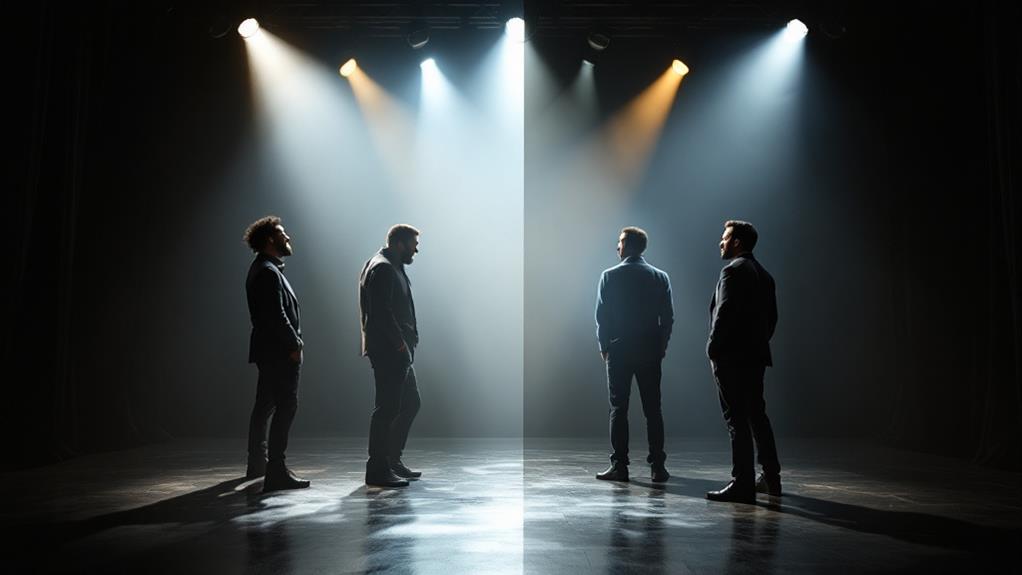
Comedy's dual nature has deeply shaped dramatic genres throughout history. You'll find its influence in various forms of theater, from ancient Greek plays to modern Broadway productions. The Origins of the Comedy can be traced back to the Greek muses Thalia and Melpomene, representing comedy and tragedy respectively. This duality has given rise to diverse genres of Comedy, each blending laughter and tears in unique ways.
When you watch a comedic performance, you're experiencing a delicate dance between humor and pathos. The emotions the characters portray often mirror the intricacies of real life, allowing you to connect with the story on a deeper level. This interplay between joy and sorrow has led to the development of subgenres like:
- Tragicomedy, where laughter mingles with tears
- Dark comedy, exploring taboo subjects through humor
- Romantic comedy, balancing love and laughter
- Satirical comedy, using wit to critique society
Legacy in Performing Arts
Two iconic symbols have come to represent the entire gamut of performing arts: the comedy and tragedy masks. These enduring emblems have evolved from their ancient Greek origins to become a universal shorthand for the emotional spectrum of human experience portrayed through various artistic mediums.
You'll recognize the comic mask, associated with Thalia, as a symbol of joy and laughter. It's often showcased with ivy and a bugle, embodying the lighter side of life and the celebration of dance. In contrast, the tragedy mask, linked to Melpomene, represents sorrow and drama. It's typically shown with a knife or club, symbolizing the darker aspects of human existence.
These masks transcend their theatrical roots, encompassing a broad range of artistic expressions. From Idyllic Poetry to lyric poetry, from film to dance, the comedy and tragedy masks remind you of the arts' power to investigate and express the full breadth of human emotions. Their legacy in performing arts is undeniable, serving as a visual representation of the duality inherent in creative expression and the human condition itself.



